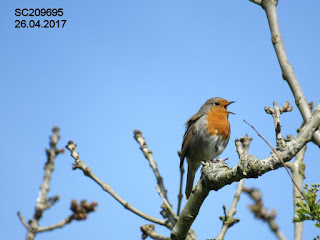 |
| A blue-sky day at Ballachurry Reserve. |
Birds:
SC209693 2 x Sparrowhawk together being hassled by a corvid
SC208694 single Sparrowhawk about an hour later over the reserve near the willow walk.
SC209694 ( from hide) 2 x Mallard ( female is hybrid); Wren.
SC208694 ( Willow walk/ compost area) Great Tit; Willow Warbler heard but not seen; Chiffchaff heard but not seen;
SC209694 ( path junction) male Pheasant; Wren; Willow Warbler preening.
SC208695 (old beehive loop) 3 x Goldfinch; Chiffchaff; Robin;
SC209695 ( near orchard entrance) Willow Warbler; male Chaffinch; Robin;
SC209694 Goldcrest; Dunnock preening;
SC208694 Grasshopper Warbler heard but not seen from area behind the reed bed.
Ladybirds:
SC210694 1 x parasitised 7-spot Ladybird ; 2 x other 7-spot Ladybirds
SC209694 7-spot Ladybird
SC208694 2 x 7-spot Ladybird
SC209694 tiny 10-spot Ladybird ( I would have missed this one had I not stopped to examine the gorse closely, looking for Shieldbugs)
Butterflies:
SC210694 Small Tortoiseshell
SC209694 2 x Small Tortoiseshell; male Orange Tip
SC208694 male Orange Tip
SC208695 male Orange Tip
SC209695 male Orange Tip; Small Tortoiseshell
Shieldbugs:
SC210694 Green Shieldbug on nettles ( couldn't get close for photo!)
SC209693 3 x Green Shieldbug on brambles
SC208695 3 x Gorse Shieldbugs
SC209695 pair of mating Gorse Shieldbugs + 10 x singletons ( I have not managed to spot any eggs yet)
SC209694 20 + Gorse Shieldbugs
Mammals:
SC208694 While standing on the bridge listening to the Grasshopper Warbler a Longtail (the R-word) paddled across the rather shallow stream from one bank to the other.
Flies and Wasps etc:
SC210694 our poor parasitised Ladybird tells us we have Dinocampus coccinellae wasps on the reserve (New Record) .
SC208695 Eristalis pertinax Hoverfly; Common Wasp.
SC209695 Unidentified Hoverfly; 2 x Water Crickets
SC210694 Unidentified Hoverfly
SC208694 Unidentified Hoverfly
Plants and flowers:
SC209693 Ladysmock now in flower throughout reserve including this location
SC209694 there is one solitary native bluebell in the wildflower meadow! Elsewhere in the reserve they are the Spanish variety; large marsh thistle rosette close to the path.
SC208695 some of the Blackthorns have leaf galls. I have not yet been able to find out more about these, but whatever is causing them will be a new record for the Reserve.
SC208694 Horsetail and Meadowsweet are coming up through the compost heap.
SC208694 What I think is Angelica has appeared for the first time amongst the willows.
 |
| Parisitised 7-spot Ladybird |
 |
| 7-spot Ladybird |
 |
| another 7-spot Ladybird |
 |
| 10-spot Ladybird - these are very small compared to a 7-spot. |
 |
| click to enlarge |
 |
| freshly preened Dunnock |
 |
| Green Shieldbug |
 |
| Gorse Shieldbug |
 |
| mating Gorse Shieldbugs |
 |
| this Willow Warbler was preening and singing alternately |
 |
| Small Tortoiseshell |
 |
| and another |
 |
| Unidentified Hoverfly |
 |
| Unidentified Hoverfly |
 |
| Chaffinch |
 |
| Leaf gall on Blackthorn |
 |
| more leaf galls on Blackthorn |
 |
| Ballachurry's only native bluebell? |
 |
| marsh thistle |
 |
| Eristalis pertinax Hoverfly |
 |
| singing Robin |
 |
| Ladysmock /Cuckoo flower - one of the food plants for Orange Tip butterflies. |
 |
| female hybrid mallard |
 |
| Unidentified Hoverfly |
 |
| and another |
 |
| yet another |
 |
| Red campion |
 |
| Spring colours |
And finally, a word on weather lore: the oak was out before the ash at Ballachurry this year, which meant we only had a splash - it has certainly been very dry of late. Had the ash been out before the oak, then we would have had a soak. They are both out together now, and have been joined by Sycamore.
 |
| young Oak leaves against the blue sky |
 |
| young Ash leaves against the blue sky |
 |
| and Sycamore leaves against the blue sky just for good measure. |